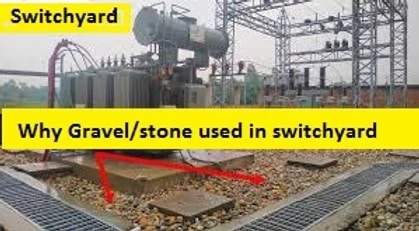Grit in the electrical switchyard is laid to make the upper surface of the soil more resistive. The more resistivity of the soil decreases the step and touch potential. The reduced step and touch potential reduce the possibility of an electric shock.
In this post, we will discuss in detail how grit increases the resistivity of the upper part of the soil.

The gravel has higher resistivity in order of 59000-96000 Ohm-cm. The gravel size of 25-30 mm is used in the switchyard. Why do we require the upper surface more resistive?
Reasons of Laying grit in the electrical switchyard
We will discuss the reasons for the grit laying in detail in the subsequent sections of the post.
Gravel Decreases the Step Potential, How?
The fault current flows through the ground and voltage is developed between two points across the switchyard. The technical term of voltage developed between the two points is called the step potential.
The step potential is the voltage developed between the two feet on the ground or animal during short circuit current flows in the ground. It is desired that the step voltage must be as minimum as possible.
The current flowing on the upper surface of the ground is limited by the gravel, and thus the potential difference between the two points decreases with an increase in the resistivity of the gravel. This is how the step potential gets decreased.
Current through human body = step potential/ Body Resistance
The lesser the step potential, the safer it is to work in the switchyard. Thus, the grit in the electrical switchyard reduces the step potential.
Gravel Decreases the Touch Potential, How?
Touch potential is the voltage developed between the equipment body and the ground. The gravel provides very high resistance and it causes very little current through the upper surface which has gravel.
The decrease in the touch potential causes less current through the human body when someone touches the structure of the equipment. Thus, the grit in the electrical switchyard reduces the touch potential.
Gravel prevents growth of weeds
The stone/ gravel prevents the growth of small weeds, climbers, and other plants inside the switchyard. The small weeds and grass may increase the step and touch potential because the resistance of the upper surface gets decreased with weeds and grass. When the weed’s growth is hindered, the possibility of reptiles in the area can be prevented.
Gravel reduces the possibility of Fire in the Switchyard
The switchyard has oil-filled transformers inside it. The spilled oil seeps through the grit /stone and does not remain on the upper surface. Thus in case of fire, the upper area does not catch fire and thus prevents the spreading of fire in the switchyard.
Gravel increase the conductivity of the lower layer below the gravel/grit/stone
The rainwater passes through the gravel and seeped into the soil, thus the resistivity of the lower layer gets decreased which is desired for power system protection. Also, after rain, the stone/gravels get dried up quickly, and again the resistivity of the upper surface gets increased.
PRECAUTION:
NEVER GO INSIDE THE SWITCHYARD WHEN RAIN IS POURING BECAUSE THE STEP AND TOUCH POTENTIAL IS HIGH BECAUSE OF INCREASED CONDUCTIVITY OF UPPER SURFACE.
THE POSSIBILITY OF LIGHTNING INCIDENT VOLTAGE IS MUCH MORE DURING RAINING.
Grit/gravel laying in substation is it required as per CEA or any other regulatery requirement ?